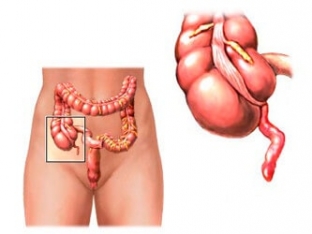Appendicitis is the most common surgical pathology. The disease is not considered so dangerous and severe if the signs of appendicitis are immediately noticed, and surgery is started on time. But there are several forms of appendicitis, one of which is phlegmonous appendicitis. This is the most dangerous course of the inflammatory process in the appendix, in which it is covered with purulent plaque and can burst. Such a course greatly complicates the process, threatening the development of peritonitis and sepsis. What are the signs of appendicitis in its phlegmonous form of inflammation?
Pathological signs of appendicitis in phlegmonous form
With the development of a phlegmonous form of appendicitis in the appendix, its walls become red, swollen, the mucous membrane is loose, the appearance of ulcers on it indicates a phlegmonous - ulcerative form. The appendix becomes thickened, its surface is covered with fibrin plaque. Plaque may spread to nearby peritoneal and intestinal tissues.
In the cavity of the appendix with phlegmonous appendicitis there is a purulent liquid that is green or gray in color. Pus may ooze onto the surface of the appendix, appearing as a cloudy, infected fluid. When examining the tissues of the appendix under a microscope, leukocyte infiltration is present from all layers.
In some cases, an empyema of the appendix may form. Pathological signs of appendicitis in the development of empyema are clogging of the lumen of the appendix with a fecal stone or scar tissue. At the same time, the appendix is swollen and tense, a positive symptom of fluctuation is determined in it.
Main symptoms and clinical signs of appendicitis
Phlegmonous appendicitis, as a rule, develops a few hours after catarrhal. Signs of appendicitis during the transition to the phlegmonous form can be seen with an increase in the intensity of abdominal pain. First, the patient feels weakness, nausea, abdominal pain, which does not have a clear localization. Later, the pain is concentrated in the right iliac region and is clearly felt there.
 But with an atypical location of the appendix, the pain is localized in the right hypochondrium, in the pelvis or lower back. The pain is pulsating constant in nature, can intensify with coughing, sneezing and laughing. With an increase in pain, the patient takes a forced position - lying on his right side with legs bent at the knees and hip joints.
But with an atypical location of the appendix, the pain is localized in the right hypochondrium, in the pelvis or lower back. The pain is pulsating constant in nature, can intensify with coughing, sneezing and laughing. With an increase in pain, the patient takes a forced position - lying on his right side with legs bent at the knees and hip joints.
What are the clinical signs of appendicitis?
With phlegmonous appendicitis, the patient feels intoxication - fever up to 38-38.50C, loss of appetite, headache, weakness and nausea, tachycardia, and there are also signs of digestive system dysfunction - diarrhea or constipation, flatulence, dryness and coating on the tongue. A complete blood count shows leukocytosis with a sharp shift of the formula to the left. In this case, the pain may not be intense at first, and not cause excitement throughout the day.
The presence of positive abdominal symptoms is one of the signs of appendicitis:
- Tension of the muscles of the peritoneum in the area of pain localization.
- Retraction of the right iliac region during the act of breathing.
- Positive Shchetkin-Blumberg symptom.
- Symptom of Resurrection - when sliding the hand from the ribs to the groin, the pain intensifies in the patient.
- Sitkovsky's symptom - increased pain when trying to lie on the left side.
- Rovsing and Bartomier-Mikhelson positive symptom.
What is the danger of appendicitis? Complications of phlegmonous appendicitis
If the treatment of phlegmonous appendicitis is not timely, it can have the following complications:
- Appendix rupture with peritonitis development.
- Intestinal obstruction.
- Development of thrombophlebitis of the iliac or pelvic veins.
- Formation of an appendicular abscess or infiltrate.
- Purulent inflammation or thrombosis of the liver veins.
- Development of an abdominal abscess.
Early diagnosis of appendicitis can prevent all dangerous consequences and save the health of patients. Be careful with abdominal pain and don't waste time developing the first signs of appendicitis.






Add a comment